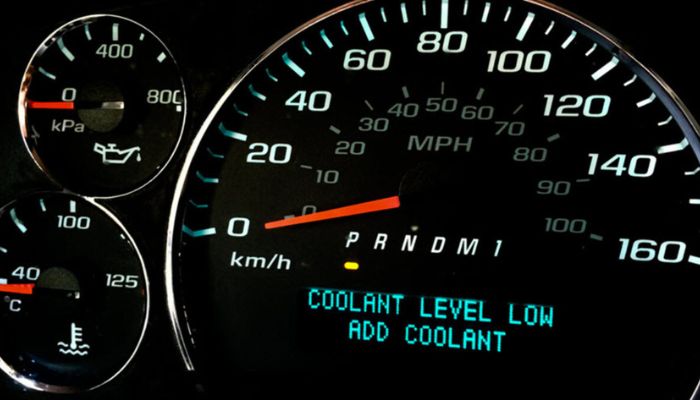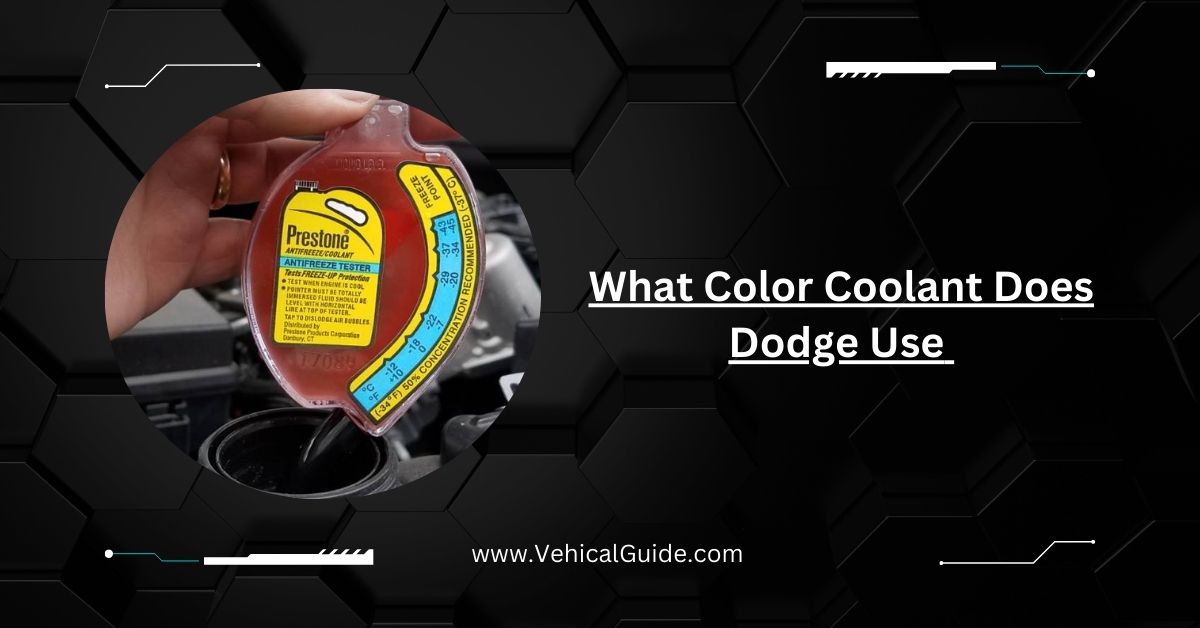Table of Contents
I learned a lot about the importance of coolant for my Dodge vehicle after reading this article. Before, I didn’t realize there were different types of coolant and how crucial it is to use the right one.
Dodge vehicles usually use pink or red HOAT coolant, which protects against corrosion. Mixing different coolant types can cause serious damage, so it’s essential to use the right one.
In this article, learn how to pick the right coolant for your Dodge!
What type of coolant does Dodge use – Check Your Coolant!
Dodge vehicles generally use Hybrid Organic Acid Technology (HOAT) coolant, which is commonly identified by its pink or red color. This type of coolant is specially formulated to offer effective protection against corrosion and overheating in the engine’s cooling system.
HOAT coolants combine traditional inorganic additives with modern organic compounds, making them suitable for various engine materials, including aluminum, which is commonly found in many modern engines.
Why is coolant color important – Protect Your Engine!
The color of coolant is an important indicator of its type and chemical composition. Different colors usually signify different formulations and additive packages. For instance, a pink or red coolant often indicates HOAT, while green coolant is generally associated with traditional inorganic coolants.
Each type of coolant serves different engine requirements to maximize performance and protect the engine from temperature extremes and internal corrosion. Using a coolant that is not recommended for your vehicle can result in various problems, such as engine overheating, clogged cooling passages.
Can I mix different coolant colors – Drive Without Worries!

Mixing different colors of coolant is not advisable. Each coolant color corresponds to a specific formulation, and combining them can lead to unwanted chemical reactions that may form sludge and precipitates within the radiator and other cooling system components.
Such issues can lead to blockages, overheating, and in severe cases, engine damage. If you find yourself in a situation where you need to top off your coolant but do not have the same type on hand, it is recommended to flush the entire cooling system and replace it with the correct type of coolant that matches your vehicle’s specifications.
How often should I change my coolant – Catch Leaks Early!
- General Recommendation: Most experts suggest changing your coolant every 2 to 4 years.
- Owner’s Manual: Always check your car’s owner’s manual for the specific maintenance schedule.
- Mileage Guidelines: Some guidelines recommend changing coolant every 30,000 to 50,000 miles.
- Signs of Old Coolant: Look for signs like rust, discoloration, or a sweet smell, which indicate it’s time for a change.
- Type of Coolant: Different vehicles use different types of coolant. Make sure to use the correct type for your car.
- Driving Conditions: If you often drive in harsh conditions, like extreme heat or cold, consider changing your coolant more frequently.
- Seasonal Checks: Before winter and summer, check your coolant level and condition.
- Cooling System Issues: If your car has overheating issues, old or low coolant might be the cause.
- Professional Inspections: Regularly have your cooling system checked by a mechanic, especially if your car is older.
- DIY Checks: If you prefer to do it yourself, test the coolant’s concentration and pH level with testing strips.
What happens if I use the wrong coolant – Prevent Overheating!
Using the wrong type of coolant in your Dodge can lead to a host of severe issues. Each coolant is designed with specific additives to prevent corrosion, reduce boiling points, and maintain the coolant’s effectiveness over time.
If you introduce a coolant that is not compatible with your vehicle, you may experience corrosion of engine components, clogged hoses, and diminished heating performance. In more severe cases, engine overheating can occur, leading to catastrophic failure such as a blown head gasket or cracked engine block.
Can I use aftermarket coolant in my Dodge – Protect Your Engine!
While it is possible to use aftermarket coolant in your Dodge, it is crucial to ensure that it meets the specific requirements set by the manufacturer. Look for coolants that are explicitly labeled as compatible with HOAT systems or those specified in your owner’s manual.
Many respected brands offer coolants that meet or exceed OEM specifications. However, it’s important to be cautious, as some aftermarket coolants may contain different additives that could potentially cause harm to your engine.
What is HOAT coolant?
HOAT stands for Hybrid Organic Acid Technology, a formulation designed to provide optimal protection for modern engines. HOAT coolant combines traditional inorganic additives with more modern organic compounds.
This blend delivers superior corrosion resistance and helps prevent overheating while being compatible with various engine metals, including aluminum. The common colors for HOAT coolant are pink and red, making them easily identifiable.
What are the signs of low coolant – Know Your Coolant!

Low coolant levels can lead to various engine problems, and recognizing the signs early can prevent costly damage. Common indicators include an overheating engine, which may trigger a warning light on your dashboard.
You may also notice insufficient heating if the interior of your vehicle is not warming up when the heater is turned on, as the heating system relies on engine coolant to produce heat. Additionally, physical signs, such as puddles or stains underneath the vehicle or a sweet smell of coolant coming from the engine compartment, are also indications of low coolant.
What are the symptoms of a coolant leak?
Overheating Engine:
An overheating engine is one of the most typical indicators of a coolant leak. Your vehicle’s thermostat regulates the engine temperature, and if there isn’t enough coolant circulating, the engine can become too hot.
Puddles Under the Car:
If you notice bright green, orange, or pink puddles under your car, this may indicate a coolant leak. Coolant is typically colored for safety reasons, making it easy to identify if it’s leaking. The puddle may be located directly under the front of the vehicle.
Sweet Smell:
Coolant has a sweet smell, often described as similar to syrup. If you notice this scent while driving or when you step out of your car, it could mean there is a leak somewhere in your coolant system.
Low Coolant Level:
Regularly check the coolant reservoir. If you find that the level is consistently low, you might have a leak that needs to be addressed. Most vehicles have a translucent reservoir with markings indicating the minimum and maximum levels.
Steam from the Engine:
If you see steam coming from under the hood, especially after the engine has been running, this can indicate that coolant is leaking and the engine is overheating. If this steam is accompanied by any of the other symptoms.
How can I check my coolant level?
To check your coolant level, it’s important to take safety precautions. Always wait for the engine to cool down completely before opening the hood, as coolant systems operate under pressure and can cause burns. Locate the coolant reservoir.
it’s usually a translucent container located near the radiator. Most reservoirs will have markings indicating the minimum and maximum levels. If the coolant is below the minimum line, you need to add more.
Is it necessary to flush the cooling system?
Flushing the cooling system is not always necessary, but it is a good practice in certain situations. Flushing helps remove any old coolant, rust, debris, and buildup that could affect the performance of the cooling system.
Over time, contaminants can accumulate and make the coolant less effective, leading to potential overheating or corrosion. If you notice your coolant is discolored or if you’ve switched from one coolant type to another, flushing the system is crucial to ensuring compatibility and effectiveness.
How do I identify coolant type?

Identifying the type of coolant in your vehicle is crucial for ensuring optimal performance and avoiding potential problems. Start by checking the color of the coolant in the reservoir or radiator; common colors include pink or red for HOAT coolants, green for standard traditional coolants, and orange for Dexcool-type coolants, often used in GM vehicles.
However, color alone can sometimes be misleading due to variations in formulations. To accurately determine the coolant type, refer to your owner’s manual, which will specify the recommended coolant for your Dodge model.
FAQs:
Can coolant get old?
Yes, coolant can and does get old over time, losing its effectiveness. As coolant ages, the chemical additives that protect the engine and the cooling system can become depleted, leading to increased acidity.
Is there a difference in coolant for diesel and gasoline engines?
There is indeed a difference in the coolant required for diesel and gasoline engines due to the higher operating temperatures and pressures in diesel engines. Diesel engines typically generate more heat and require a coolant that can withstand these conditions without breaking down.
If my coolant is discolored, what should I do?
If you notice that your coolant has become discolored, it may indicate contamination or a breakdown of the coolant’s chemical properties. Discolored coolant may appear rusty, brown, or murky, which is a sign that it is no longer effective at protecting your engine.
How can I prevent coolant leaks?
Preventing coolant leaks is essential for maintaining engine health and avoiding costly repairs. Regular inspections of your cooling system can help identify wear and tear before leaks develop.
Is coolant considered hazardous waste?
Yes, used coolant is classified as hazardous waste due to its toxicity, particularly if it contains ethylene glycol, a common ingredient in many antifreeze formulations. If ingested, it is harmful to both humans and animals.
In The End:
In summary, it’s crucial to pay attention to signs of a coolant leak in your car, such as overheating, puddles, or a sweet smell. If you notice any of these symptoms or need to refill coolant often, you should visit a mechanic soon. Engine damage can be expensive if these problems are ignored.


